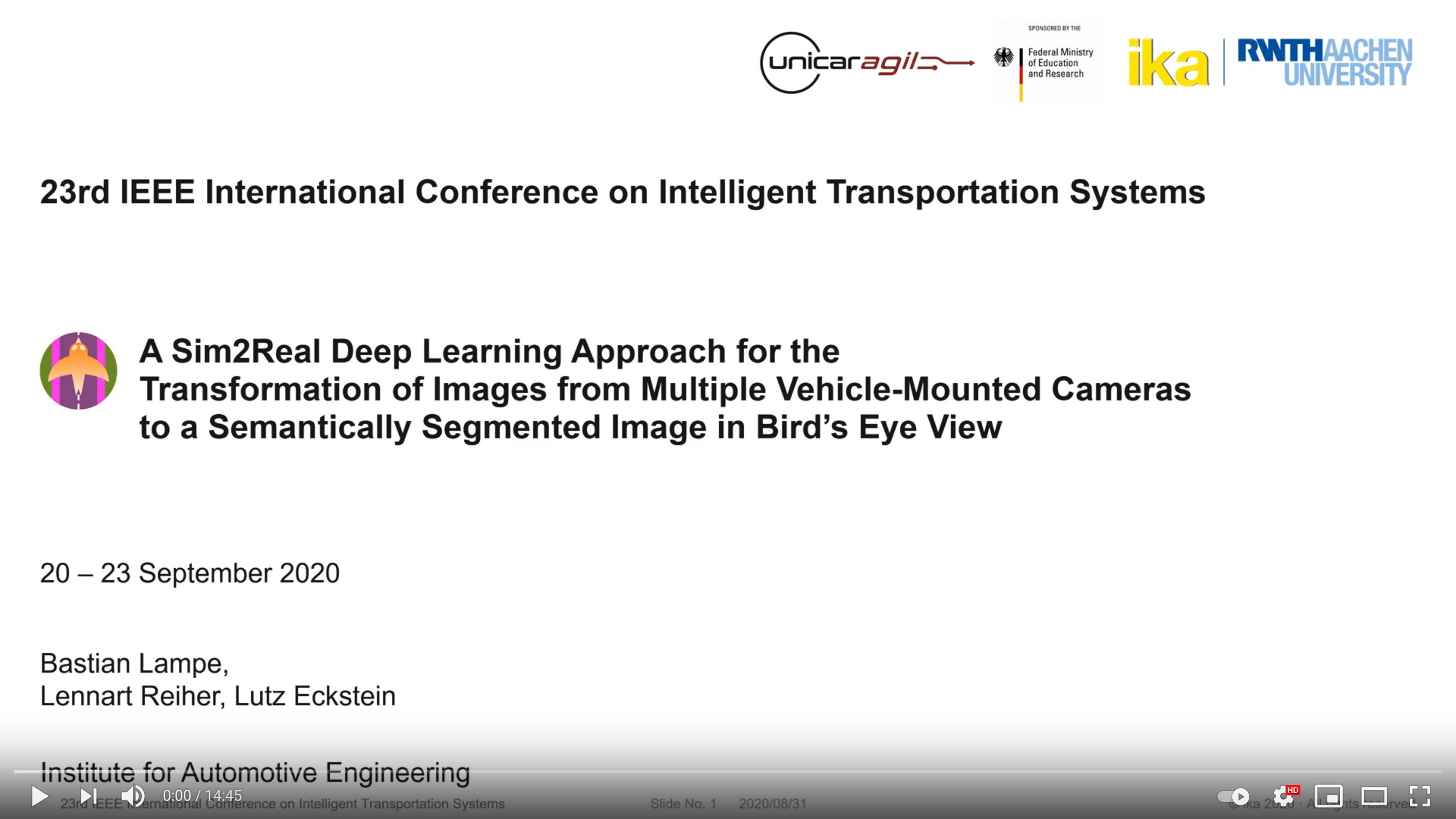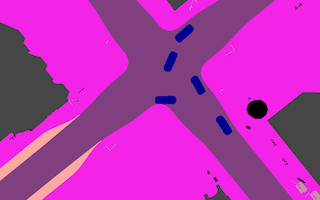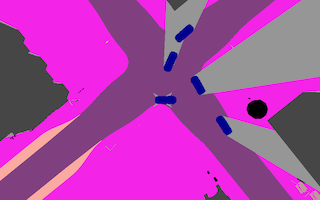ika-rwth-aachen / Cam2bev
Programming Languages
Projects that are alternatives of or similar to Cam2bev
 Cam2BEV
Cam2BEV

This repository contains the official implementation of our methodology for the computation of a semantically segmented bird's eye view (BEV) image given the images of multiple vehicle-mounted cameras as presented in our paper:
A Sim2Real Deep Learning Approach for the Transformation of Images from Multiple Vehicle-Mounted Cameras to a Semantically Segmented Image in Bird’s Eye View (IEEE Xplore, arXiv)
Lennart Reiher, Bastian Lampe, and Lutz Eckstein
Institute for Automotive Engineering (ika), RWTH Aachen University
Abstract — Accurate environment perception is essential for automated driving. When using monocular cameras, the distance estimation of elements in the environment poses a major challenge. Distances can be more easily estimated when the camera perspective is transformed to a bird's eye view (BEV). For flat surfaces, Inverse Perspective Mapping (IPM) can accurately transform images to a BEV. Three-dimensional objects such as vehicles and vulnerable road users are distorted by this transformation making it difficult to estimate their position relative to the sensor. This paper describes a methodology to obtain a corrected 360° BEV image given images from multiple vehicle-mounted cameras. The corrected BEV image is segmented into semantic classes and includes a prediction of occluded areas. The neural network approach does not rely on manually labeled data, but is trained on a synthetic dataset in such a way that it generalizes well to real-world data. By using semantically segmented images as input, we reduce the reality gap between simulated and real-world data and are able to show that our method can be successfully applied in the real world. Extensive experiments conducted on the synthetic data demonstrate the superiority of our approach compared to IPM.
We hope our paper, data and code can help in your research. If this is the case, please cite:
@INPROCEEDINGS{ReiherLampe2020Cam2BEV,
author={L. {Reiher} and B. {Lampe} and L. {Eckstein}},
booktitle={2020 IEEE 23rd International Conference on Intelligent Transportation Systems (ITSC)},
title={A Sim2Real Deep Learning Approach for the Transformation of Images from Multiple Vehicle-Mounted Cameras to a Semantically Segmented Image in Bird’s Eye View},
year={2020},
doi={10.1109/ITSC45102.2020.9294462}}
Content
- Repository Structure
- Installation
- Data
- Preprocessing
- Training
- Neural Network Architectures
- Customization
Repository Structure
Cam2BEV
├── data # where our synthetic datasets are downloaded to by default
├── model # training scripts and configurations
│ ├── architecture # TensorFlow implementations of neural network architectures
│ └── one_hot_conversion # files defining the one-hot encoding of semantically segmented images
└── preprocessing # preprocessing scripts
├── camera_configs # files defining the intrinsics/extrinsics of the cameras used in our datasets
├── homography_converter # script to convert an OpenCV homography for usage within the uNetXST SpatialTransformers
├── ipm # script for generating a classical homography image by means of IPM
└── occlusion # script for introducing an occluded class to the BEV images
Installation
We suggest to setup a Python 3.7 virtual environment (e.g. by using virtualenv or conda). Inside the virtual environment, users can then use pip to install all package dependencies. The most important packages are TensorFlow 2.1 and OpenCV 4.2
pip install -r requirements.txt
Data
We provide two synthetic datasets, which can be used to train the neural networks. The datasets are hosted in the Cam2BEV Data Repository. Both datasets were used to produce the results presented in our paper:
- Dataset 1_FRLR: images from four vehicle-mounted cameras, ground-truth BEV image centered above the ego vehicle
- Dataset 2_F: images from one frontal vehicle camera; ground-truth BEV image left-aligned with ego vehicle
For more information regarding the data, please refer to the repository's README.
Both datasets can easily be downloaded and extracted by running the provided download script:
./data/download.sh
Note: Download size is approximately 3.7GB, uncompressed size of both datasets is approximately 7.7GB.
Preprocessing
Our paper describes two preprocessing techniques:
(1) introducing an occluded class to the label images and
(2) generating the homography image.
1) Dealing with Occlusions
Traffic participants and static obstacles may occlude parts of the environment making predictions for those areas in a BEV image mostly impossible. In order to formulate a well-posed problem, an additional semantic class needs to be introduced to the label images for areas in BEV, which are occluded in the camera perspectives. To this end, preprocessing/occlusion can be used. See below for an example of the occlusion preprocessing.
Run the following command to process the original label images of dataset 1_FRLR and introduce an occluded class. You need to provide camera intrinsics/extrinsics for the drone camera and all vehicle-attached cameras (in the form of the yaml files).
Note: In batch mode, this script utilizes multiprocessing. It can however still take quite some time to process the entire dataset. Therefore, we also provide already preprocessed data.
cd preprocessing/occlusion
./occlusion.py \
--batch ../../data/1_FRLR/train/bev \
--output ../../data/1_FRLR/train/bev+occlusion \
../camera_configs/1_FRLR/drone.yaml \
../camera_configs/1_FRLR/front.yaml \
../camera_configs/1_FRLR/rear.yaml \
../camera_configs/1_FRLR/left.yaml \
../camera_configs/1_FRLR/right.yaml
See preprocessing/occlusion/README.md for more information.
2) Projective Preprocessing
As part of the incorporation of the Inverse Perspective Mapping (IPM) technique into our methods, the homographies, i.e. the projective transformations between vehicle camera frames and BEV need to be computed. As a preprocessing step to the first variation of our approach (Section III-C), IPM is applied to all images from the vehicle cameras. The transformation is set up to capture the same field of view as the ground truth BEV image. To this end, preprocessing/ipm can be used. See below for an example homography image computed from images of four vehicle-mounted cameras.
Run the following command to compute a homography BEV image from all camera images of dataset 1_FRLR. You need to provide camera intrinsics/extrinsics for the drone camera and all vehicle-attached cameras (in the form of the yaml files).
Note: To save time, we also provide already preprocessed data.
cd preprocessing/ipm
./ipm.py --batch --cc \
--output ../../data/1_FRLR/train/homography \
--drone ../camera_configs/1_FRLR/drone.yaml \
../camera_configs/1_FRLR/front.yaml \
../../data/1_FRLR/train/front \
../camera_configs/1_FRLR/rear.yaml \
../../data/1_FRLR/train/rear \
../camera_configs/1_FRLR/left.yaml \
../../data/1_FRLR/train/left \
../camera_configs/1_FRLR/right.yaml \
../../data/1_FRLR/train/right
See preprocessing/ipm/README.md for more information.
Training
Use the scripts model/train.py, model/evaluate.py, and model/predict.py to train a model, evaluate it on validation data, and make predictions on a testing dataset.
Input directories, training parameters, and more can be set via CLI arguments or in a config file. Run the scripts with --help-flag or see one of the provided exemplary config files for reference. We provide config files for either one of the networks and datasets:
- model/config.1_FRLR.deeplab-mobilenet.yml
- model/config.1_FRLR.deeplab-xception.yml
- model/config.1_FRLR.unetxst.yml
- model/config.2_F.deeplab-mobilenet.yml
- model/config.2_F.deeplab-xception.yml
- model/config.2_F.unetxst.yml
The following commands will guide you through training uNetXST on dataset 1_FRLR.
Training
Start training uNetXST by passing the provided config file model/config.1_FRLR.unetxst.yml. Training will automatically stop if the MIoU score on the validation dataset is not rising anymore.
cd model/
./train.py -c config.1_FRLR.unetxst.yml
You can visualize training progress by pointing TensorBoard to the output directory (model/output by default). Training metrics will also be printed to stdout.
Evaluation
Before evaluating your trained model, set the parameter model-weights to point to the best_weights.hdf5 file in the Checkpoints folder of its model directory. Then run evaluation to compute a confusion matrix and class IoU scores.
./evaluate.py -c config.1_FRLR.unetxst.yml --model-weights output/<YOUR-TIMESTAMP>/Checkpoints/best_weights.hdf5
The evaluation results will be printed at the end of evaluation and also be exported to the Evaluation folder in your model directory.
Testing
To actually see the predictions your network makes, try it out on unseen input images, such as the validation dataset. The predicted BEV images are exported to the directory specified by the parameter output-dir-testing.
./predict.py -c config.1_FRLR.unetxst.yml --model-weights output/<YOUR-TIMESTAMP>/Checkpoints/best_weights.hdf5 --prediction-dir output/<YOUR-TIMESTAMP>/Predictions
Neural Network Architectures
We provide implementations for the use of the neural network architectures DeepLab and uNetXST in model/architecture. DeepLab comes with two different backbone networks: MobileNetV2 or Xception.
DeepLab
The DeepLab models are supposed to take the homography images computed by Inverse Perspective Mapping (preprocessing/ipm) as input.
Configuration
- set
modeltoarchitecture/deeplab_mobilenet.pyorarchitecture/deeplab_xception.py - set
input-trainingand the other input directory parameters to the folders containing the homography images - comment
unetxst-homographiesin the config file or don't supply it via CLI, respectively
uNetXST
The uNetXST model contains SpatialTransformer units, which perform IPM inside the network. Therefore, when building the network, the homographies to transform images from each camera need to be provided.
Configuration
- set
modeltoarchitecture/uNetXST.py - set
input-trainingand the other input directory parameters to a list of folders containing the images from each camera (e.g.[data/front, data/rear, data/left, data/right]) - set
unetxst-homographiesto a Python file containing the homographies as a list of NumPy arrays stored in a variableH(e.g.../preprocessing/homography_converter/uNetXST_homographies/1_FRLR.py)- we provide these homographies for our two datasets in preprocessing/homography_converter/uNetXST_homographies/1_FRLR.py and preprocessing/homography_converter/uNetXST_homographies/2_F.py
- in order to compute these homographies for different camera configurations, follow the instructions in preprocessing/homography_converter
Customization
I want to set different training hyperparameters
Run the training script with --help-flag or have a look at one of the provided exemplary config files to see what parameters you can easily set.
I want the networks to work on more/fewer semantic classes
The image datasets we provide include all 30 CityScapes class colors. How these are reduced to say 10 classes is defined in the one-hot conversion files in model/one_hot_conversion. Use the training parameters --one-hot-palette-input and --one-hot-palette-label to choose one of the files. You can easily create your own one-hot conversion file, they are quite self-explanatory.
If you adjust --one-hot-palette-label, you will also need to modify --loss-weights. Either omit the parameter to weight all output classes evenly, or compute new suitable loss weights. The weights found in the provided config files were computed (from the model directory) with the following Python snippet.
import numpy as np
import utils
palette = utils.parse_convert_xml("one_hot_conversion/convert_9+occl.xml")
dist = utils.get_class_distribution("../data/1_FRLR/train/bev+occlusion", (256, 512), palette)
weights = np.log(np.reciprocal(list(dist.values())))
print(weights)
I want to use my own data
You will need to run the preprocessing methods on your own data. A rough outline on what you need to consider:
- specify camera intrinsics/extrinsics similar to the files found in preprocessing/camera_configs
- run preprocessing/occlusion/occlusion.py
- run preprocessing/occlusion/ipm.py
- compute uNetXST-compatible homographies by following the instructions in preprocessing/homography_converter
- adjust or create a new one-hot conversion file (model/one_hot_conversion)
- set all training parameters in a dedicated config file
- start training




